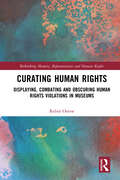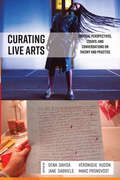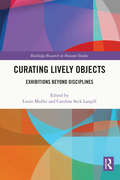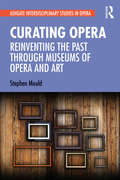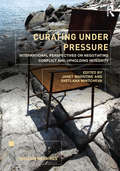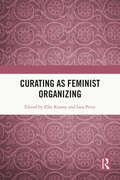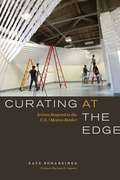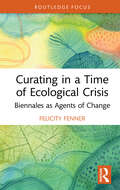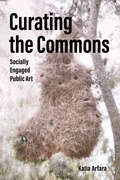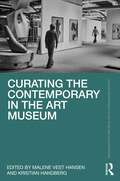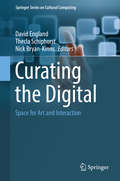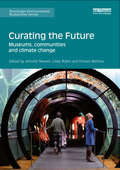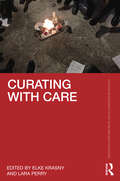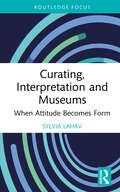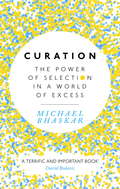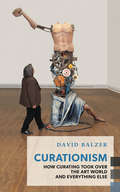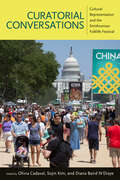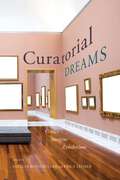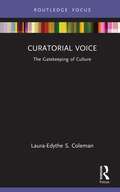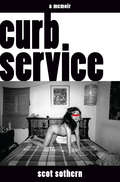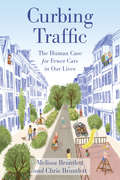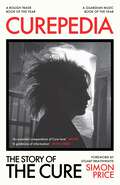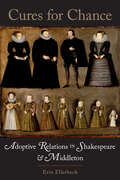- Table View
- List View
Curating Human Rights: Displaying, Combating and Obscuring Human Rights Violations in Museums (Rethinking Memory, Representation and Human Rights)
by Robin OstowCurating Human Rights conceptualizes the human rights museum as a dynamic cultural-political genre that interacts with multiple social activist, state and corporate stakeholders.Drawing upon ethnographic and archival research on seven human rights museums in six countries, Ostow examines specifically what these museums do when they set out, or purport, to promote human rights. This includes the stories they visualize, display strategies, educational and other activities, internal structures, the way they position their visitors, the parameters of the human rights they address and the politics of pleasing their multiple stakeholders. The book also explores the contradictions and political and corporate pressure that contributes to foregrounding some human rights violations and ignoring or obscuring others. Ostow also examines the reactions to each museum in the local and national press, and by local visitors, politicians, donors and other stakeholders. The book ends with a discussion of the success and limitations of museums for promoting human rights, and policy recommendations to enhance their effectiveness. Curating Human Rights considers whether these museums are appropriate for, and effective at, promoting human rights - and if they address the pitfalls that have been identified.Curating Human Rights provides new perspectives on the field of human rights education and activism and will be of interest to academics and students engaged in the study of museums, human rights, culture and communication.
Curating Live Arts: Critical Perspectives, Essays, and Conversations on Theory and Practice
by Dena Davida Marc Pronovost Véronique Hudon Jane GabrielsSituated at the crossroads of performance practice, museology, and cultural studies, live arts curation has grown in recent years to become a vibrant interdisciplinary project and a genuine global phenomenon. Curating Live Arts brings together bold and innovative essays from an international group of theorist-practitioners to pose vital questions, propose future visions, and survey the landscape of this rapidly evolving discipline. Reflecting the field’s characteristic eclecticism, the writings assembled here offer practical and insightful investigations into the curation of theatre, dance, sound art, music, and other performance forms—not only in museums, but in community, site-specific, and time-based contexts, placing it at the forefront of contemporary dialogue and discourse.
Curating Lively Objects: Exhibitions Beyond Disciplines (Routledge Research in Museum Studies)
by Lizzie Muller Caroline Seck LangillCurating Lively Objects explores the role of things as catalysts in imagining futures beyond disciplines for museums and exhibitions. Authors describe how their curatorial collaborations with diverse objects, from rocks to robots, generate new ways of organising and sharing knowledge. Bringing together leading artists and curators from Australia and Canada, this volume addresses object liveliness from a range of entwined perspectives, including new materialism, decolonial thinking, Indigenous epistemologies, environmentalism, feminist critique and digital aesthetics. Foregrounding practice-based curatorial scholarship, the book focuses on rigorous reflexive accounts of how curating is done. It contributes to global topics in curatorial research, including time and memory beyond and before disciplinarity; the relationship between human and non-human across different ontologies; and the interaction between Indigenous knowledge and disciplinary expertise in interpreting museum collections. Curating Lively Objects will be of interest to scholars and students in the fields of curatorial studies, museum studies, cultural heritage, art history, Indigenous studies, material culture and anthropology. It also provides a vital resource for professionals working in museums and galleries around the world who are seeking to respond creatively, ethically and inclusively to the challenge of changing disciplinary boundaries.
Curating Opera: Reinventing the Past Through Museums of Opera and Art (Ashgate Interdisciplinary Studies in Opera)
by Stephen MouldCuration as a concept and a catchword in modern parlance has, over recent decades, become deeply ingrained in modern culture. The purpose of this study is to explore the curatorial forces at work within the modern opera house and to examine the functionaries and processes that guide them. In turn, comparisons are made with the workings of the traditional art museum, where artworks are studied, preserved, restored, displayed and contextualised – processes which are also present in the opera house. Curatorial roles in each institution are identified and described, and the role of the celebrity art curator is compared with that of the modern stage director, who has acquired previously undreamt-of licence to interrogate operatic works, overlaying them with new concepts and levels of meaning in order to reinvent and redefine the operatic repertoire for contemporary needs. A point of coalescence between the opera house and the art museum is identified, with the transformation, towards the end of the nineteenth century, of the opera house into the operatic museum. Curatorial practices in the opera house are examined, and further communalities and synergies in the way that ‘works’ are defined in each institution are explored. This study also considers the so-called ‘birth’ of opera around the start of the seventeenth century, with reference to the near-contemporary rise of the modern art museum, outlining operatic practice and performance history over the last 400 years in order to identify the curatorial practices that have historically been employed in the maintenance and development of the repertoire. This examination of the forces of curation within the modern opera house will highlight aspects of authenticity, authorial intent, preservation, restoration and historically informed performance practice.
Curating Under Pressure: International Perspectives on Negotiating Conflict and Upholding Integrity (Museum Meanings)
by Janet Marstine Svetlana MintchevaCurating Under Pressure breaks the silence surrounding curatorial self-censorship and shows that it is both endemic to the practice and ubiquitous. Contributors map the diverse forms such self-censorship takes and offer creative strategies for negotiating curatorial integrity. This is the first book to look at pressures to self-censor and the curatorial responses to these pressures from a wide range of international perspectives. The book offers examples of the many creative strategies that curators deploy to negotiate pressures to self-censor and gives evidence of curators’ political acumen, ethical sagacity and resilience over the long term. It also challenges the assumption that self-censorship is something to be avoided at all costs and suggests that a decision to self-censor may sometimes be politically and ethically imperative. Curating Under Pressure serves as a corrective to the assumption that censorship pressures render practitioners impotent. It demonstrates that curatorial practice under pressure offers inspiring models of agency, ingenuity and empowerment. Curating Under Pressure is a highly original and intellectually ambitious volume and as such will be of great interest to students and academics in the areas of museum studies, curatorial and gallery studies, art history, studio art and arts administration. The book will also be an essential tool for museum practitioners.
Curating as Feminist Organizing
by Lara Perry Elke KrasnyWhat makes curating feminist organizing? How do curators relate to contemporary feminist concerns in their local conditions and the globalized artworld? The book brings together twenty curatorial case studies from diverse regions of the globe. Reflecting their own curatorial projects or analyzing feminist-inspired exhibitions, the authors in this book elaborate feminist curating as that which is inspired to challenge gender politics not only within but also beyond the doors of the museum and gallery. Connecting their wider feminist politics to their curatorial practices, the book provides case studies of curatorial practice that address the legacies of racialized and ethnic violence, including colonialism; which seek to challenges the state's regulation of citizenship and sexuality; and which realize the drive for economic justice in the organizations and roles in which curators work. The settings in which this work is done range from university art galleries to artist-run spaces and educational or activist programmes. This collection will be enjoyed by those studying and researching curating, exhibitions, socially and ecologically engaged contemporary art practices, and feminist transnational movements in diverse geographic contexts. The essays are of relevance to practicing curators, critical cultural practitioners, and artists.
Curating at the Edge: Artists Respond to the U.S./Mexico Border
by Kate BonansingaLocated less than a mile from Juárez, the Stanlee and Gerald Rubin Center for Visual Arts at the University of Texas at El Paso is a non-collecting institution that serves the Paso del Norte region. In Curating at the Edge, Kate Bonansinga brings to life her experiences as the Rubin’s founding director, giving voice to a curatorial approach that reaches far beyond the limited scope of “border art” or Chicano art. Instead, Bonansinga captures the creative climate of 2004–2011, when contemporary art addressed broad notions of destruction and transformation, irony and subversion, gender and identity, and the impact of location on politics. The Rubin’s location in the Chihuahuan desert on the U. S. /Mexican border is meaningful and intriguing to many artists, and, consequently, Curating at the Edge describes the multiple artistic perspectives conveyed in the place-based exhibitions Bonansinga oversaw. Exciting mid-career artists featured in this collection of case studies include Margarita Cabrera, Liz Cohen, Marcos Ramírez ERRE, and many others. Recalling her experiences in vivid, first-person scenes, Bonansinga reveals the processes a contemporary art curator undertakes and the challenges she faces by describing a few of the more than sixty exhibitions that she organized during her tenure at the Rubin. She also explores the artists’ working methods and the relationship between their work and their personal and professional histories (some are Mexican citizens, some are U. S. citizens of Mexican descent, and some have ancestral ties to Europe). Timely and illuminating, Curating at the Edge sheds light on the work of the interlocutors who connect artists and their audiences.
Curating in a Time of Ecological Crisis: Biennales as Agents of Change
by Felicity FennerCurating in a Time of Ecological Crisis reaffirms the relevance and impactful role of art, revealing how contemporary art exhibitions can capture the zeitgeist and advance new and collaborative approaches to a more sustainable inhabitation of Earth. The book is largely focused on biennales, which it argues are the contemporary exhibition models with the greatest capacity to offer new perspectives and propose alternative ways of connecting with our social and natural environments. Felicity Fenner demonstrates this by showing how curators of these high-profile exhibitions are responding in creative and engaging ways to the issues that preoccupy artists and society more broadly, of which the ecological crisis is paramount. Drawing on case studies from different parts of the world, the author reveals how biennales can make a constructive contribution to debates and attitudes around climate change, and how the role of the curator has evolved to re-embrace a duty of care not just to art but to the natural world as well. Curating in a Time of Ecological Crisis investigates how large-scale exhibitions of contemporary international art can become agents of change. As such, the book will be essential reading for scholars, students, and practitioners with an interest in exhibitions, curating, contemporary art, and environmental sustainability.
Curating the Commons: Socially Engaged Public Art
by Katia Arfara Aikaterini ArfaraSince the 2008 financial crisis and Occupy movements around the globe, artists have increasingly turned to socially engaged public art to create new models of artistic production and community engagement. Curating the Commons examines this turn through an in-depth study of performance-centered public art presented in Athens and Piraeus, Greece, during the austerity years. Extending from Henri Lefebvre’s theory of social space, Arfara examines art and social engagement in relation to the commons and self-organized solidarity initiatives, including performance, photography, film, and sculptures that appeared in unexpected urban spaces to complicate notions of memory, mobility, and belonging. These works all ask the question: Who has the right to the city? Combining her scholarly and curatorial work, Arfara advocates for performance-centered public art that resists processes of exclusion and segregation, reclaiming public space as a commons. By sharing critical insights, Arfara immerses the reader in the working processes of artists and collectives, showing how public art can address ecosocial concerns in aesthetic forms. Curating the Commons offers a grounded perspective on the making of cutting-edge, socially engaged public artworks and contributes to the larger effort to craft more-than-human narratives in response to global events.
Curating the Contemporary in the Art Museum (Routledge Research in Art Museums and Exhibitions)
by Malene Vest HansenCurating the Contemporary in the Art Museum investigates the art museum as a space where the contemporary is staged – in exhibitions, collecting practices, communication, and policies. Curating the Contemporary in the Art Museum traces the art museum back to the postwar era. Including contributions by established and emerging art historians, academics and curators, the book proposes that the art museum is engaged in the contemporary in a double sense: it (re)presents contemporary art, while the contemporary condition itself also has a significant impact on art and the museum that houses it. Presenting a diverse range of international cases of exhibitions and curatorial practices, which hail primarily from Europe and Scandinavia, the essays examine the politics of staging “national”, “international”, and “global” framings of modernism, as well as the new public spaces shaped in digital practices and changing political frameworks. The book investigates both the seminal and the unknown exhibitions and institutions that created contemporary art as we know it today. Curating the Contemporary in the Art Museum provides a historical perspective on the museum of contemporary art. It constitutes a step towards differencing the canon of modernist and contemporary art and a more complex understanding of the politics of curating the contemporary in the art museum, why it will be of interest to academics and students engaged in the study of museums, curating, exhibitions, and art history.
Curating the Digital: Space for Art and Interaction (Springer Series on Cultural Computing #0)
by David England Thecla Schiphorst Nick Bryan-KinnsThis bookcombines work from curators, digital artists, human computer interactionresearchers and computer scientists to examine the mutual benefits andchallenges posed when working together to support digital art works in theirmany forms. In Curating the Digitalwe explore how we can work together to make space for art and interaction. Welook at the various challenges such as the dynamic nature of our media, theproblems posed in preserving digital art works and the thorny problems of howwe assess and measure audience's reactions to interactive digital work. Curating the Digital is an outcome of a multi-disciplinary workshop that took place atSICHI2014 in Toronto. The participants from the workshop reflected on the themeof Curating the Digital via a series of presentations and rapid prototypingexercises to develop a catalogue for the future digital art gallery. Theresults produce a variety of insights both around the theory and philosophy ofcurating digital works, and also around the practical and technicalpossibilities and challenges. We present these complimentary chapters so thatother researchers and practitioners in related fields will find motivation andimagination for their own work.
Curating the Future: Museums, Communities and Climate Change (Routledge Environmental Humanities)
by Libby Robin Jennifer Newell Kirsten WehnerCurating the Future: Museums, Communities and Climate Change explores the way museums tackle the broad global issue of climate change. It explores the power of real objects and collections to stir hearts and minds, to engage communities affected by change. Museums work through exhibitions, events, and specific collection projects to reach different communities in different ways. The book emphasises the moral responsibilities of museums to address climate change, not just by communicating science but also by enabling people already affected by changes to find their own ways of living with global warming. There are museums of natural history, of art and of social history. The focus of this book is the museum communities, like those in the Pacific, who have to find new ways to express their culture in a new place. The book considers how collections in museums might help future generations stay in touch with their culture, even where they have left their place. It asks what should the people of the present be collecting for museums in a climate-changed future? The book is rich with practical museum experience and detailed projects, as well as critical and philosophical analyses about where a museum can intervene to speak to this great conundrum of our times. Curating the Future is essential reading for all those working in museums and grappling with how to talk about climate change. It also has academic applications in courses of museology and museum studies, cultural studies, heritage studies, digital humanities, design, anthropology, and environmental humanities.
Curating the Future: Museums, Communities and Climate Change (Routledge Environmental Humanities)
by Libby Robin Jennifer Newell Kirsten WehnerCurating the Future: Museums, Communities and Climate Change explores the way museums tackle the broad global issue of climate change. It explores the power of real objects and collections to stir hearts and minds, to engage communities affected by change. Museums work through exhibitions, events, and specific collection projects to reach different communities in different ways. The book emphasises the moral responsibilities of museums to address climate change, not just by communicating science but also by enabling people already affected by changes to find their own ways of living with global warming. There are museums of natural history, of art and of social history. The focus of this book is the museum communities, like those in the Pacific, who have to find new ways to express their culture in a new place. The book considers how collections in museums might help future generations stay in touch with their culture, even where they have left their place. It asks what should the people of the present be collecting for museums in a climate-changed future? The book is rich with practical museum experience and detailed projects, as well as critical and philosophical analyses about where a museum can intervene to speak to this great conundrum of our times. Curating the Future is essential reading for all those working in museums and grappling with how to talk about climate change. It also has academic applications in courses of museology and museum studies, cultural studies, heritage studies, digital humanities, design, anthropology, and environmental humanities.
Curating with Care (Routledge Research in Art Museums and Exhibitions)
by Lara Perry Elke KrasnyThis book presents over 20 authors’ reflections on ‘curating care’ – and presents a call to give curatorial attention to the primacy of care for all life and for more ‘caring curating’ that responds to the social, ecological and political analysis of curatorial caregiving. Social and ecological struggles for a different planetary culture based on care and respect for the dignity of life are reflected in contemporary curatorial practices that explore human and non-human interdependence. The prevalence of themes of care in curating is a response to a dual crisis: the crisis of social and ecological care that characterizes global politics and the professional crisis of curating under the pressures of the increasingly commercialized cultural landscape. Foregrounding that all beings depend on each other for life and survival, this book collects theoretical essays, methodological challenges and case studies from curators working in different global geographies to explore the range of ways in which curatorial labour is rendered as care. Practising curators, activists and theorists situate curatorial labour in the context of today’s general care crisis. This volume answers to the call to more fully understand how their transformative work allows for imagining the future of bodily, social and environmental care and the ethics of interdependency differently.
Curating, Interpretation and Museums: When Attitude Becomes Form (Routledge Focus on the Global Creative Economy)
by Sylvia LahavFollowing a period of strategic and ideological change in museums, this book outlines new attitudes in curating and display, education and learning, text and interpretation, access, inclusion, participation, space, and the issues around the sustainability of the encyclopaedic collection. Focused on the contemporary period, the author questions the extent to which the museum visitor has become reliant on interpretative text and examines the development of new museum spaces where visitor interaction and engagement is welcomed. Changes of attitude have transformed our museums into modern spaces that reflect current needs and modern expectations and yet our permanent collections remain relatively unchanged, sometimes an uncomfortable reminder of a time when values, ethics, and attitudes were very different. The author will discuss these conflicts of ideology. Written by a researcher with expertise in museum practice, this shortform book offers a new approach that will be valuable reading for students and scholars of cultural management and policy, as well as providing insights for reflective museum practitioners.
Curation: The power of selection in a world of excess
by Michael Bhaskar'A terrific and important book . . . it's a great, fresh take on how the 21st century is transforming the way we select everything from food to music' David Bodanis, author of E=MC2In the past two years humanity has produced more data than the rest of human history combined. We carry a library of data in our pockets, accessible at any second. We have more information and more goods at our disposal than we know what to do with. There is no longer any competitive advantage in creating more information. Today, value lies in curation: selecting, finding and cutting down to show what really matters.Curation reveals how a little-used word from the world of museums became a crucial and at times controversial strategy for the twenty-first century. Today's most successful companies - Apple, Netflix, Amazon - have used curation to power their growth, by offering customers more tailored and appropriate choices.Curation answers the question of how we can live and prosper in an age of information overload. In the context of excess, it is not only a sound business strategy, but a way to make sense of the world.
Curationism: How Curating Took Over the Art World and Everything Else (Exploded Views)
by David Balzer"Now that we 'curate' even lunch, what happens to the role of the connoisseur in contemporary culture?'Curate' is now a buzzword applied to everything from music festivals to artisanal cheese. Inside the art world, the curator reigns supreme, acting as the face of high-profile group shows and biennials in a way that can eclipse and assimilate the contributions of individual artists. At the same time, curatorial studies programs continue to grow in popularity, and businesses are increasingly adopting curation as a means of adding value to content and courting demographics. Everyone, it seems, is a now a curator. But what is a curator, exactly? And what does the explosive popularity of curating say about our culture's relationship with taste, labour and the avant-garde?In this incisive and original study, critic David Balzer travels through art history and around the globe to explore the cult of curation - where it began, how it came to dominate museums and galleries, and how it was co-opted at the turn of the millennium as the dominant mode of organizing and giving value to content. At the centre of the book is a paradox: curation is institutionalized and expertise-driven like never before, yet the first independent curators were not formally trained, and any act of choosing has become 'curating.' Is the professional curator an oxymoron? Has curation reached a sort of endgame, where its widespread fetishization has led to its own demise?David Balzer has contributed to publications including the Believer, Modern Painters, Artforum.com, and The Globe and Mail, and is the author of Contrivances, a short-fiction collection. He is currently Associate Editor at Canadian Art magazine. Balzer was born in Winnipeg and currently resides in Toronto, where he makes a living as a critic, editor and teacher.
Curatorial Conversations: Cultural Representation and the Smithsonian Folklife Festival
by Olivia Cadaval Sojin Kim Diana Baird N’DiayeSince its origins in 1967, the Smithsonian Folklife Festival has gained worldwide recognition as a model for the research and public presentation of living cultural heritage and the advocacy of cultural democracy. Festival curators play a major role in interpreting the Festival's principles and shaping its practices. Curatorial Conversations brings together for the first time in one volume the combined expertise of the Festival's curatorial staff—past and present—in examining the Center for Folklife and Cultural Heritage’s representation practices and their critical implications for issues of intangible cultural heritage policy, competing globalisms, cultural tourism, sustainable development and environment, and cultural pluralism and identity. In the volume, edited by the staff curators Olivia Cadaval, Sojin Kim, and Diana Baird N’Diaye, contributors examine how Festival principles, philosophical underpinnings, and claims have evolved, and address broader debates on cultural representation from their own experience. This book represents the first concerted project by Smithsonian staff curators to examine systematically the Festival’s institutional values as they have evolved over time and to address broader debates on cultural representation based on their own experiences at the Festival.
Curatorial Dreams: Critics Imagine Exhibitions
by Shelley Butler Erica LehrerWhat if museum critics were challenged to envision their own exhibitions? In Curatorial Dreams, fourteen authors from disciplines throughout the social sciences and humanities propose exhibitions inspired by their research and critical concerns to creatively put theory into practice. Pushing the boundaries of museology, this collection gives rare insight into the process of conceptualizing exhibitions. The contributors offer concrete, innovative projects, each designed for a specific setting in which to translate critical academic theory about society, culture, and history into accessible imagined exhibitions. Spanning Australia, Barbados, Canada, Chile, the Netherlands, Poland, South Africa, Switzerland, and the United States, the exhibitions are staged in museums, scientific institutions, art galleries, and everyday sites. Essays explore political and practical constraints, imaginative freedom, and experiment with critical, participatory, and socially relevant exhibition design. While the deconstructive critique of museums remains relevant, Curatorial Dreams charts new ground, proposing unique modes of engagement that enrich public scholarship and dialogue.
Curatorial Dreams: Critics Imagine Exhibitions
by Shelley Butler Erica LehrerScholars are challenged to create their own exhibitions.
Curatorial Voice: The Gatekeeping of Culture
by Laura-Edythe S. ColemanCuratorial Voice considers the act of curation from a scientific perspective. Questioning the role of curators, the actual act of curation, and the very sound of curatorial voice, Coleman works to dispel the stereotypes that have historically shrouded the work of curators in mystery.This book draws upon groundbreaking, collaborative research conducted in five national museums in the United States and includes the voices of a diverse range of curators, who reflect, in their own words, upon their role in the construction of curatorial voice. Explaining how the curators used the Curatorial Gatekeeping Mechanisms Chart, created in partnership with the author and included in this book, Coleman demonstrates that the Chart can be used to explain difficult curatorial decisions, to start conversations about shared authority within the museum, and to articulate the value of culture to various museum stakeholders. Most importantly, perhaps, this book and the Chart will provide curators with new tools to explain and justify their valuable work to others and other readers with new ways to understand the role of museums in society.Curatorial Voice will be essential reading for museum professionals around the world, as well as scholars and students with an interest in museums, galleries, and heritage sites. It will be particularly useful to those engaged in the study of curating, collections management, and exhibition design.
Curb Service: A Memoir
by Scot SothernCruising nighttime byways for an adrenaline fix, Scot Sothern first patronized the marketplace of curbside prostitution surfing the prurient whims of a young man. He dove to the murky depths of sexual obsession and resurfaced five years later, shell-shocked and without excuse. While there, trusty Nikon in hand, Scot, a second-generation photographer, made full-frontal X-rated exposures, black and white, filled with pathos and an uncanny realism. The pictures captured the plight of the disenfranchised in America, those forgotten and drug-addicted. Now he is ready to tell the story behind the photographs, the confessions of a befuddled baby-boomer maintaining a slippery connection to propriety while side-tripping into noirish infatuations with those low in life. Curb Service recounts Sothern's past as a troubled kid in the 1960s who visited two-dollar whorehouses and as an adult in the 1980s is still at it. A photographer who either can't get a break or blows it when one comes his way, Scot wants to hold onto jobs, wives, and relationships; he tries to be a good father to the son he loves. Yet he continues picking up street prostitutes, photographing them, having sex with them, living moments of their lives and watching them fade away in a culture that deems them criminal and expendable. It was only a few years ago that Scot's photography started to receive notice - by influential Drkrm Gallery in Los Angeles - which led to the publication of Lowlife, a photo book, by Stanley Barker in the UK and soon by powerhouse in Brooklyn. His work has since been exhibited world-wide including shows in London, Los Angeles, and Ottawa.
Curbing Traffic: The Human Case for Fewer Cars in Our Lives
by Melissa Bruntlett Chris BruntlettIn Curbing Traffic: The Human Case for Fewer Cars in Our Lives, mobility experts Melissa and Chris Bruntlett chronicle their experience living in the Netherlands and the benefits that result from treating cars as visitors rather than owners of the road. They weave their personal story with research and interviews with experts and Delft locals to help readers share the experience of living in a city designed for people. Their insights will help decision makers and advocates to better understand and communicate the human impacts of low-car cities: lower anxiety and stress, increased independence, social autonomy, inclusion, and improved mental and physical wellbeing. Curbing Traffic provides relatable, emotional, and personal reasons why it matters and inspiration for exporting the low-car city.
Curepedia: An immersive and beautifully designed A-Z biography of The Cure
by Simon PriceA Rough Trade Book of the Year A Guardian Music Book of the Year 'Beautifully written and meticulously researched' Classic Pop'[An] all-encompassing repository of Cure wisdom' Record CollectorThe Cure are indisputable titans of alternative rock. Recognisable as much for their iconic aesthetic, videos and artwork as for the lyrical and musical genius of Robert Smith, The Cure's work remains hugely influential on contemporary pop culture. It reverberates through fans of all generations worldwide and through genres ranging from emo to goth, industrial to indie rock.In this fully updated edition of Curepedia, Simon Price sifts through the facts, the myths and the tall tales around The Cure, their recording history and epic tours, to deliver a uniquely kaleidoscopic portrait of the legendary band and a book that has been praised as the definitive document and account of their remarkable career.'An extraordinary piece of work' Elis James'A pleasure to study and absorb - highly recommended' Tim Burgess
Cures for Chance: Adoptive Relations in Shakespeare and Middleton
by Erin EllerbeckAdoption allows families to modify, either overtly or covertly, what is considered to be the natural order. Cures for Chance explores how early modern English theatre questioned the inevitability of the biological family and proposed new models of familial structure, financial inheritance, and gendered familial authority. Because the practice of adoption circumvents sexual reproduction, its portrayal obliges audiences to reconsider ideas of nature and kinship. This study elucidates the ways in which adoptive familial relations were defined, described, and envisioned on stage, particularly in the works of Shakespeare and Middleton. In the plays in question, families and individual characters create, alter, and manage familial relations. Throughout Cures for Chance, adoption is considered in the broader socioeconomic and political climate of the period. Literary works and a wide range of other early modern texts – including treatises on horticulture and natural history and household and conduct manuals – are analysed in their historical and cultural contexts. Erin Ellerbeck argues that dramatic representations of adoption test conventional notions of family by rendering the family unit a social construction rather than a biological certainty, and that in doing so, they evoke the alteration of nature by human hands that was already pervasive at the time.
